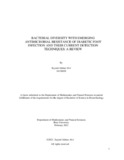| dc.contributor.advisor | Ahmed, Akash | |
| dc.contributor.advisor | Akhtar, Fahmina | |
| dc.contributor.author | Alvi, Sayeed Akhtar | |
| dc.date.accessioned | 2021-08-02T05:29:42Z | |
| dc.date.available | 2021-08-02T05:29:42Z | |
| dc.date.copyright | 2021 | |
| dc.date.issued | 2021-02 | |
| dc.identifier.other | ID: 16136028 | |
| dc.identifier.uri | http://hdl.handle.net/10361/14898 | |
| dc.description | This thesis is submitted in partial fulfillment of the requirements for the degree of Bachelor of Science in Biotechnology 2021. | en_US |
| dc.description | Catalogued from PDF version of thesis. | |
| dc.description | Includes bibliographical references (pages 41-49). | |
| dc.description.abstract | Diabetic foot ulcer is becoming one of the major complications around the world with associated
consequences such as lower-extremity amputation, high morbidity, mortality and hospitalization.
It is on its way to become the next global epidemic. Major part of the concern comes from the
diverse bacterial and fungal population that is found at the infection site and their growing
antimicrobial resistance. If the threat of antimicrobial resistance is not dealt with than it will rise
to become the main cause of mortality and below knee amputation in case DFI. Also, most of the
time main focus is given on detecting bacterial population which causes the fungal population to
go unnoticed and act as the silent enemy. Bacterial and fungal prevalence scenario from different
countries have been discussed in this study along with the alarming antibiotic resistance scenario
around the globe. Furthermore, choosing the correct technique to identify them also plays a vital
role. With proven lacking’s of the culture-based methods maybe it is time to move on to the faster
and more specific molecular methods. As, many of the molecular techniques have already proven
to be more efficient. This review discussed the bacterial and fungal prevalence along with their
growing antimicrobial resistance and evaluated different biochemical and molecular techniques in
identification process. | en_US |
| dc.description.statementofresponsibility | Sayeed Akhtar Alvi | |
| dc.format.extent | 49 Pages | |
| dc.language.iso | en_US | en_US |
| dc.publisher | Brac University | en_US |
| dc.rights | Brac University theses are protected by copyright. They may be viewed from this source for any purpose, but reproduction or distribution in any format is prohibited without written permission. | |
| dc.subject | DFI | en_US |
| dc.subject | Causative agents | en_US |
| dc.subject | Antibiotic resistance | en_US |
| dc.subject | Wound infection | en_US |
| dc.subject | Molecular methods | en_US |
| dc.subject | Biochemical tests | en_US |
| dc.title | Bacterial diversity with emerging antimicrobial resistance of diabetic foot infection and their current detection techniques: A review | en_US |
| dc.type | Thesis | en_US |
| dc.contributor.department | Department of Mathematics and Natural Sciences, Brac University | |
| dc.description.degree | B. Biotechnology | |

